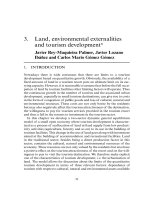THE ECONOMICS OF MONEY,BANKING, AND FINANCIAL MARKETS 479
Bạn đang xem bản rút gọn của tài liệu. Xem và tải ngay bản đầy đủ của tài liệu tại đây (37.15 KB, 1 trang )
CHAPTER 17
Tools of Monetary Policy
447
and ultimately reducing settlement balances by an amount equal to the government s net receipts. In the absence of any offsetting transactions by the Bank of
Canada, through the workings of supply and demand, a decline in settlement balances will normally cause an increase in the overnight interest rate, as many LVTS
participants would have to borrow more to meet their settlement obligations.
However, in targeting the overnight interest rate, the Bank of Canada will neutralize the net government receipt by arranging a net increase of $100 in the government deposit auctions to leave the system unchanged. This procedure results
in the following balance sheets for the Bank and the LVTS participants:
Bank of Canada
Assets
LVTS Participants
Liabilities
Government
deposits
Settlement
balances
*100
Assets
Liabilities
Settlement
balances +100
Government
deposits
+100
+100
Note that government deposits at the Bank of Canada are reduced by $100 and at
the same time the settlement balances of the LVTS participants are increased by
$100.
If instead of a net receipt by the government, there was a net disbursement of
$100 (i.e., the government s payments to the public exceed its receipts from the
public by $100), then the financial system s settlement balances would increase by
the same amount. This would prompt a fall in the overnight interest rate, as many
LVTS participants would have to borrow less to meet their settlement obligations.
The Bank s neutralization process would prevent a decline in the overnight rate
by reducing the banking system s settlement balances. This would involve LVTS
transfers of $100 (i.e., the difference between the total amount of government balances maturing and the total amount of government balances auctioned) from the
government s accounts at the participating institutions to the government s account
at the Bank. This procedure results in the following T-accounts:
Bank of Canada
Assets
LVTS Participants
Liabilities
Government
deposits
Settlement
balances
Assets
+100
Settlement
balances
Liabilities
*100
Government
deposits
*100
*100
In this case government deposits at the Bank of Canada are increased by $100 and
at the same time the clearing balances of the participants are reduced by $100.
Swaps with
the Exchange
Fund Account
When the Bank of Canada transfers government balances, it usually brings onto
its balance sheet Exchange Fund Account assets to back its liabilities. It does so by
arranging a swap with the Exchange Fund Account, which holds the country s foreign exchange reserves. This involves a spot purchase and a simultaneous forward









